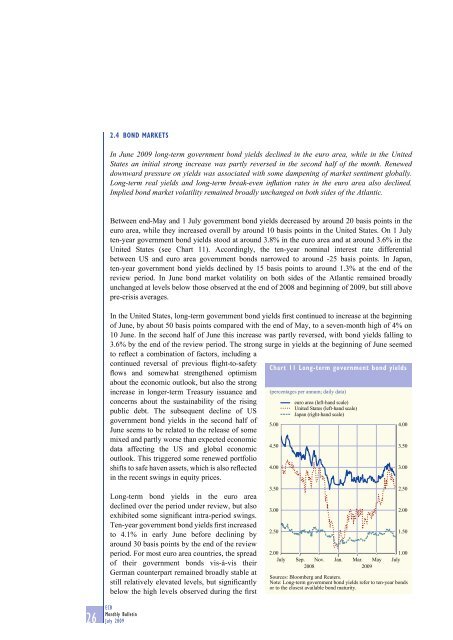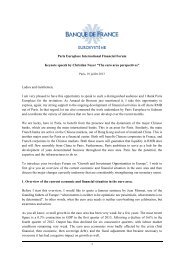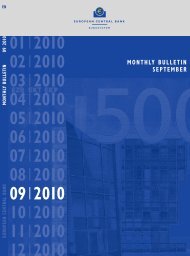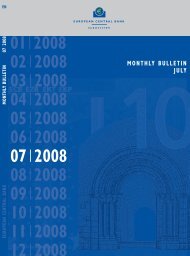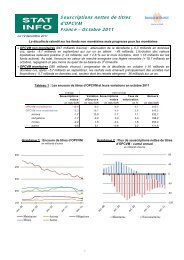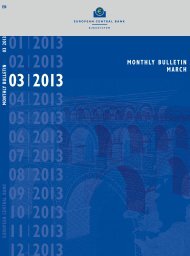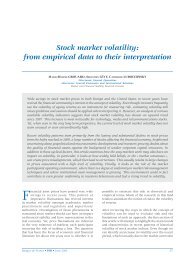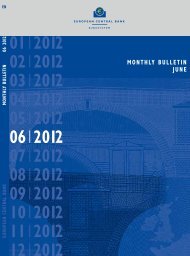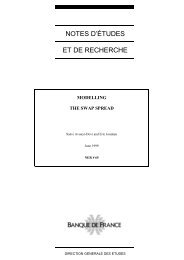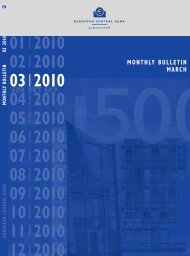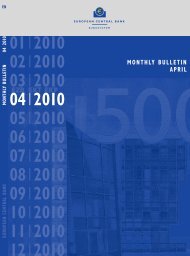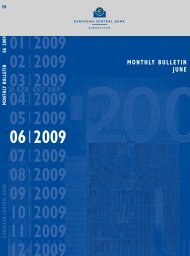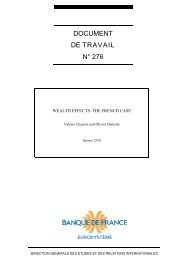Monthly Bulletin July 2009 - Banque de France
Monthly Bulletin July 2009 - Banque de France
Monthly Bulletin July 2009 - Banque de France
Create successful ePaper yourself
Turn your PDF publications into a flip-book with our unique Google optimized e-Paper software.
2.4 BOND MARKETS<br />
In June <strong>2009</strong> long-term government bond yields <strong>de</strong>clined in the euro area, while in the United<br />
States an initial strong increase was partly reversed in the second half of the month. Renewed<br />
downward pressure on yields was associated with some dampening of market sentiment globally.<br />
Long-term real yields and long-term break-even infl ation rates in the euro area also <strong>de</strong>clined.<br />
Implied bond market volatility remained broadly unchanged on both si<strong>de</strong>s of the Atlantic.<br />
Between end-May and 1 <strong>July</strong> government bond yields <strong>de</strong>creased by around 20 basis points in the<br />
euro area, while they increased overall by around 10 basis points in the United States. On 1 <strong>July</strong><br />
ten-year government bond yields stood at around 3.8% in the euro area and at around 3.6% in the<br />
United States (see Chart 11). Accordingly, the ten-year nominal interest rate differential<br />
between US and euro area government bonds narrowed to around -25 basis points. In Japan,<br />
ten-year government bond yields <strong>de</strong>clined by 15 basis points to around 1.3% at the end of the<br />
review period. In June bond market volatility on both si<strong>de</strong>s of the Atlantic remained broadly<br />
unchanged at levels below those observed at the end of 2008 and beginning of <strong>2009</strong>, but still above<br />
pre-crisis averages.<br />
In the United States, long-term government bond yields first continued to increase at the beginning<br />
of June, by about 50 basis points compared with the end of May, to a seven-month high of 4% on<br />
10 June. In the second half of June this increase was partly reversed, with bond yields falling to<br />
3.6% by the end of the review period. The strong surge in yields at the beginning of June seemed<br />
to reflect a combination of factors, including a<br />
continued reversal of previous flight-to-safety<br />
flows and somewhat strengthened optimism<br />
about the economic outlook, but also the strong<br />
increase in longer-term Treasury issuance and<br />
concerns about the sustainability of the rising<br />
public <strong>de</strong>bt. The subsequent <strong>de</strong>cline of US<br />
government bond yields in the second half of<br />
June seems to be related to the release of some<br />
mixed and partly worse than expected economic<br />
data affecting the US and global economic<br />
outlook. This triggered some renewed portfolio<br />
shifts to safe haven assets, which is also reflected<br />
in the recent swings in equity prices.<br />
Long-term bond yields in the euro area<br />
<strong>de</strong>clined over the period un<strong>de</strong>r review, but also<br />
exhibited some significant intra-period swings.<br />
Ten-year government bond yields first increased<br />
to 4.1% in early June before <strong>de</strong>clining by<br />
around 30 basis points by the end of the review<br />
period. For most euro area countries, the spread<br />
of their government bonds vis-à-vis their<br />
German counterpart remained broadly stable at<br />
still relatively elevated levels, but significantly<br />
below the high levels observed during the first<br />
26 ECB<br />
<strong>Monthly</strong> <strong>Bulletin</strong><br />
<strong>July</strong> <strong>2009</strong><br />
Chart 11 Long-term government bond yields<br />
(percentages per annum; daily data)<br />
5.00<br />
4.50<br />
4.00<br />
3.50<br />
3.00<br />
2.50<br />
2.00<br />
<strong>July</strong><br />
euro area (left-hand scale)<br />
United States (left-hand scale)<br />
Japan (right-hand scale)<br />
Sep. Nov. Jan. Mar. May<br />
2008 <strong>2009</strong><br />
4.00<br />
3.50<br />
3.00<br />
2.50<br />
2.00<br />
1.50<br />
1.00<br />
<strong>July</strong><br />
Sources: Bloomberg and Reuters.<br />
Note: Long-term government bond yields refer to ten-year bonds<br />
or to the closest available bond maturity.


